Welcome to the enchanting world of Moroccan weddings, where traditions blend seamlessly with vibrant celebrations. The rich tapestry of customs, colors, music, and age-old practices creates a unique and memorable experience for both the couple and their guests. From pre-wedding preparations to ceremonial rituals, every aspect of a Moroccan wedding is steeped in cultural significance and attention to detail.
Come along, let’s explore Moroccan wedding traditions. See the bride’s elegant dress, the deeply meaningful rituals. They signify two souls joining. Hear lively music, watch fun dances. Experience the welcoming, ancient culture. Here, each wedding shows love, unity, and valued customs.
Key Takeaways:
- Moroccan weddings are a vibrant blend of traditions and celebrations.
- Pre-wedding preparations, such as henna ceremonies, are an integral part of Moroccan wedding culture.
- The attire and jewelry worn during Moroccan weddings hold deep cultural significance.
- Ceremonial traditions and rituals play a central role in Moroccan weddings, including the negotiation of marriage contracts and symbolic gestures.
- Music, dance, and festivities are integral to the Moroccan wedding experience.
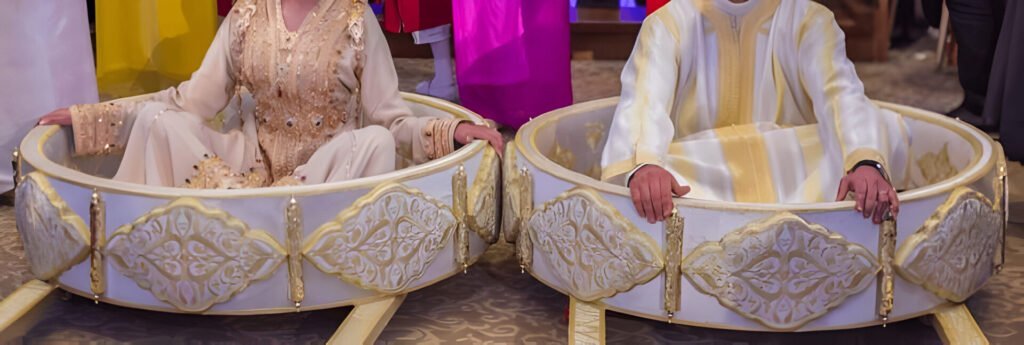
Pre-Wedding Preparations in Morocco – Moroccan Wedding
As they countdown to their big day, Moroccan pairs engage in several pre-wedding rituals. These activities enrich their joyous event and bring loads of significance. What’s more? They’re deeply infused in Moroccan marriage customs and they’re critical for the wedding journey itself.
A fun event before a Moroccan wedding is the henna tradition. You call this “Night of the Henna.” It happens a few nights before saying “I do.” It’s all about putting henna drawings on the bride’s hands and feet. The detailed designs mean good luck, safety, and lots of babies for the bride. It’s all about happiness. Family and best friends get together. They come to party. They also come to cover the bride in great henna art.
Next to the henna, Moroccan pairs also take part in other pre-nuptial customs, like heading to relatives’ homes to gain blessings and good vibes. These trips usually have gift-swappings, which shows the duos’ thankfulness and honor for their folks. It’s a method to boost familial connections and highlight the importance of togetherness and backing in Moroccan Wedding traditions.
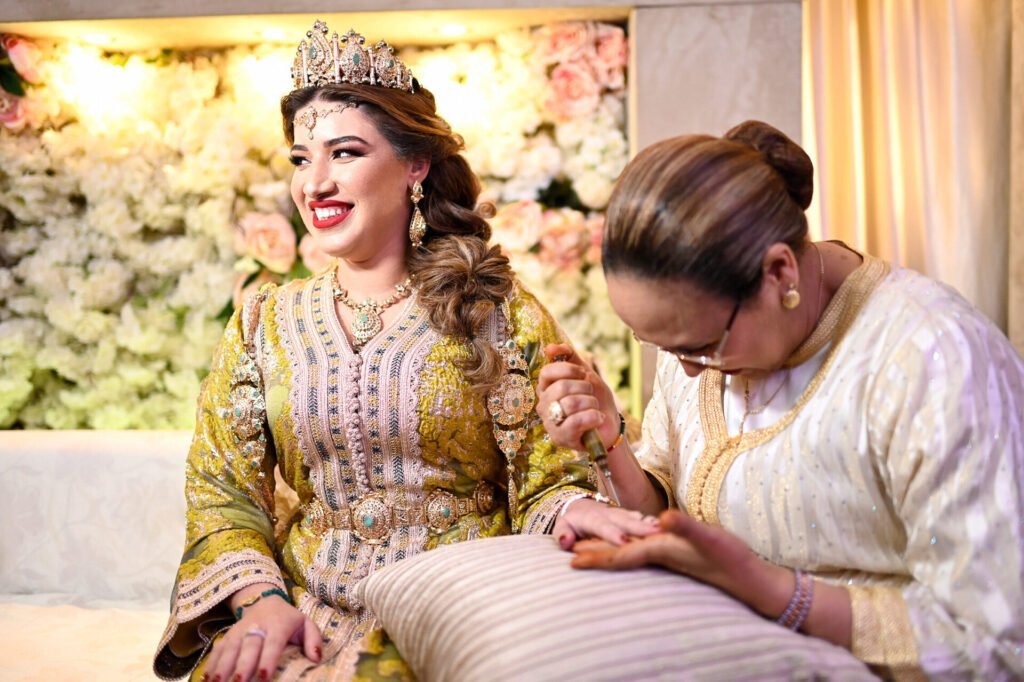
The Significance of Pre-Wedding Preparations – Moroccan Wedding
The steps taken before a Moroccan wedding aren’t just practical. They’re loaded with meaning and signals from the Moroccan culture. These tasks aren’t done in isolation, either. Everybody pitches in! It’s a chance to honor Moroccan ways and bring everyone together for some celebration.
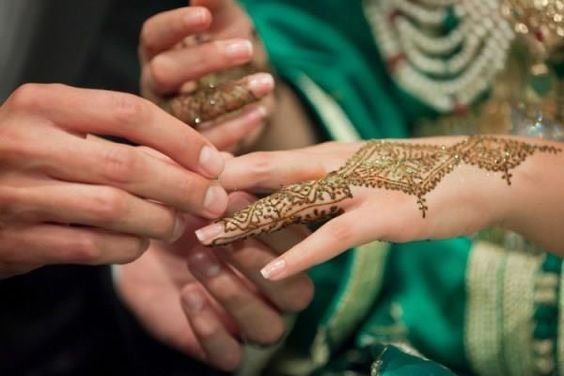
A momentous occasion is the henna ceremony. The bride’s hands and feet are delicately adorned with henna, symbolizing rich fertility, safety from malevolent spirits, and the aspiration for a peaceful and prosperous married life. Every intricate detail of the designs mirrors the talent and skill of Moroccan artists, a testament to the country’s vibrant cultural legacy.
In Morocco, getting ready for a wedding stirs up cheer, anticipation, and unity. The couple, their families, everyone’s involved. Rituals play a big part. They emphasize tradition, love, togetherness. It all leads up to a joyful, unforgettable Moroccan wedding party.
Moroccan Wedding Attire and Jewelry
Moroccan weddings are renowned for their cultural richness. Each element, from the decorations to the attire, carries a story. The bride, groom and guests wear traditional outfits. These clothes and their jewelry aren’t just for show, they hold substantial cultural meaning. They also showcase the remarkable artistry intrinsic to Moroccan culture. So, let’s take a closer look at the wedding outfits and eye-catching jewelry of the Moroccan bride.
Traditional Garments – Moroccan Wedding
Moroccan wedding spotlight? The bride, dressed in a beautiful outfit named a Caftan. Crafted from top-notch materials like silk, brocade, or velvet, it’s highlighted with detailed embroidery. Sleek features of a Caftan? Large sleeves and a relaxed shape, playing up the grace and royalty. Color of the Caftan? No set rule, yet lively reds, blues, and greens pop up frequently, echoing the wedding’s happy vibes.
The groom usually dresses in a classic outfit known as a jellaba. This jellaba is a fairly loose robe, crafted from fine fabric, often displaying subtle stitch work. A red, felt hat called a fez is regularly matched with it, giving the groom an aura of elegance. The outfit typically comes together with leather footwear known as babouches, solidifying the groom’s customary appearance.
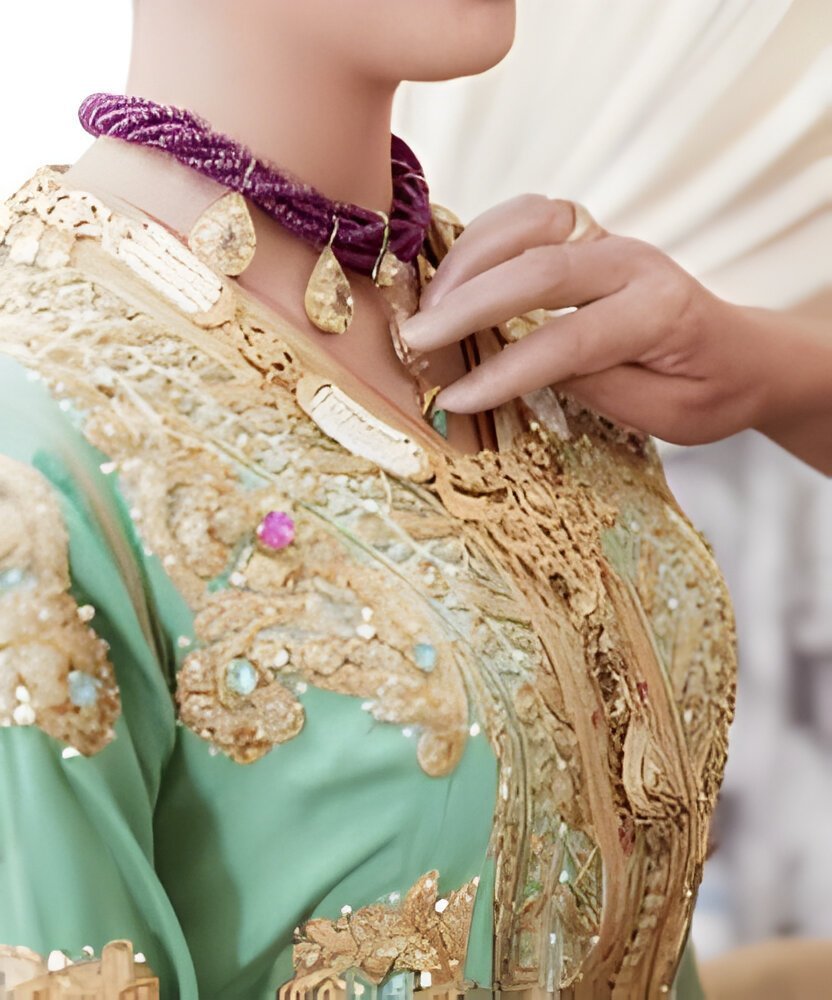
Ornate Jewelry – Moroccan Wedding
Jewelry is important in Moroccan weddings. It shows wealth, beauty, and tradition. The bride wears many special pieces of jewelry. Each piece has its own meaning. One famous piece is the Amazigh bridal headdress, also called Tasselt. This fancy headdress has complex patterns. It’s decorated with colorful gems, coins, and silk threads. It shows the bride’s place in society. It is often given from one generation to the next as a prized family treasure.
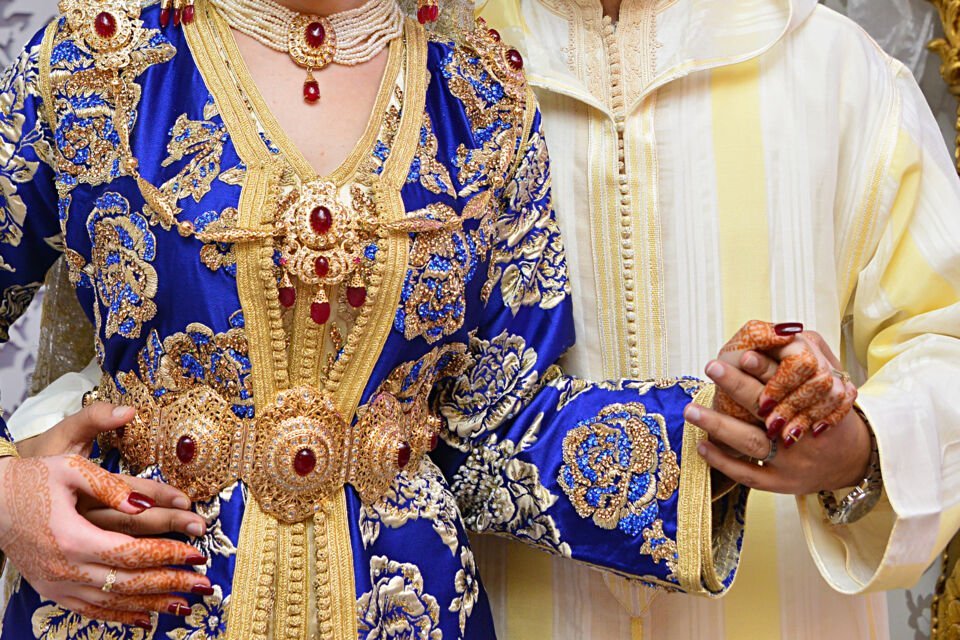
Alongside the headdress, the bride spruces up with a variety of jewelry, including necklaces, earrings, bracelets, and rings. Crafted with skill, these pieces use precious metals, like gold and silver. They’re decked out with gemstones and detailed designs like enamel work and filigree patterns. Each jewelry piece stands for something in culture; each one expressing things like love, safety, and wealth.
At the wedding, everyone appreciates Moroccan jewelry’s charm. Women flaunt dazzling necklaces, bracelets, and earrings. Men showcase detailed cufflinks and brooches. It’s a rich blend of wealth and tradition that captivates everyone.
| Attire | Jewelry |
|---|---|
| Beautiful Caftans made from luxurious fabrics | Exquisite necklaces, earrings, bracelets, and rings adorned with gemstones |
| Elegant jellabas with intricate embroidery | Iconic Amazigh bridal headdress – Tasselt |
| Fez – a traditional hat made from red felt | Colorful gemstones, coins, and silk threads embellishing the headdress |
| Leather babouches – traditional slippers | Precious metals, enamel work, and filigree patterns on the jewelry |
Ceremonial Traditions and Rituals – Moroccan Wedding
A Moroccan wedding is like a vibrant picture. It’s full of time-honored rituals from ages past. These traditions give the party a special depth. It becomes more than just a fun celebration. It’s an event that no one will ever forget.
The Negotiation of the Marriage Contract – Moroccan Wedding
In Moroccan wedding customs, arranging the marriage contract is a vital ritual. It calls for delegates from both family units to gather and settle on the union’s conditions. This age-old tradition exemplifies the value of family and community in Moroccan culture.
The Communal Feast – Moroccan Wedding
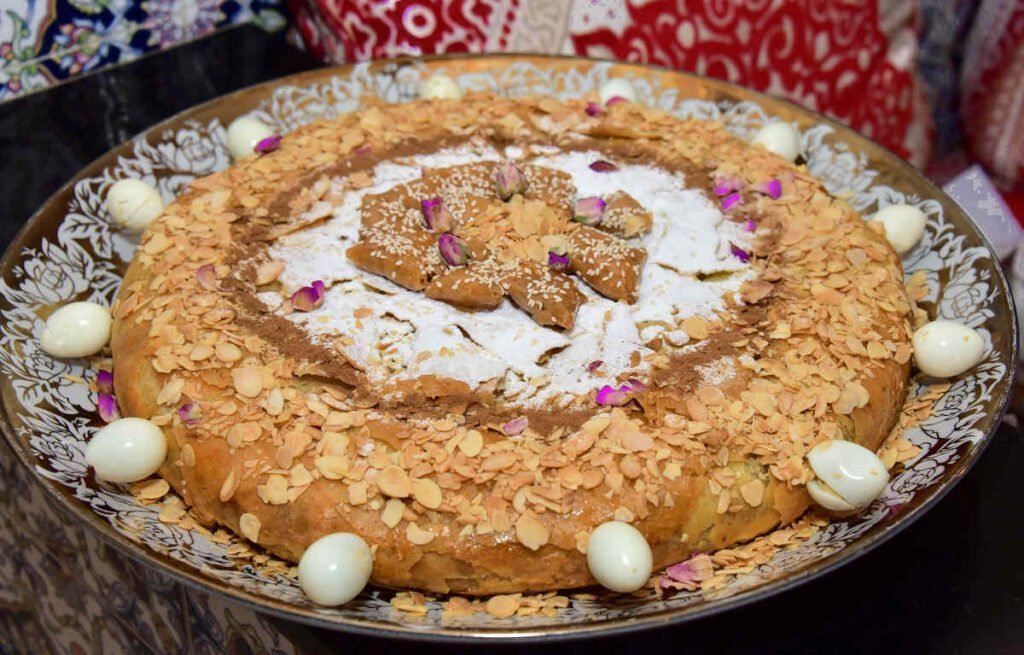
A Moroccan wedding isn’t whole without an extravagant shared meal. All assemble: families, friends. They participate in a hearty meal brimming with time-honored Moroccan food. This feast not only revels in the marrying couple’s unity but signifies the affection and solidarity interconnecting the gathering.
Symbolic Traditions during the Wedding Ceremony
The act of getting married carries many symbolic customs that are rich in cultural meaning. Take for instance the Zdeq ceremony. In this ritual, the bride has her feet cleansed with orange blossom water, signifying purification. Then there’s the swapping of wedding promises, and the smashing of the glass, with each action being loaded with significance.
| Tradition | Meaning |
|---|---|
| Henna Ceremony | A symbol of protection, good luck, and fertility for the couple |
| Tying the Knot | Represents the union and bond between the bride and groom |
| Seven Circles | A depiction of the seven stages of life as the couple begins their journey together |
| Feet Washing | A purification ritual to cleanse the couple’s souls before entering married life |
These and many other ceremonial traditions and rituals make Moroccan weddings an extraordinary experience filled with symbolism, cultural richness, and the celebration of love.
Music, Dance, and Festivities at Moroccan Weddings
Moroccan weddings stand out for their charming tunes, vibrant dances, and joyful parties. These components are vital to the event, building a mood filled with happiness and energy.
At Moroccan weddings, you’ll hear many types of music – a true display of its varied cultural roots. One significant style is Gnawa. This style started with African slaves in Morocco, blending lively beats with enchanting singing and tunes. This blend is a delightful mix that enchants guests and newly marries alike.
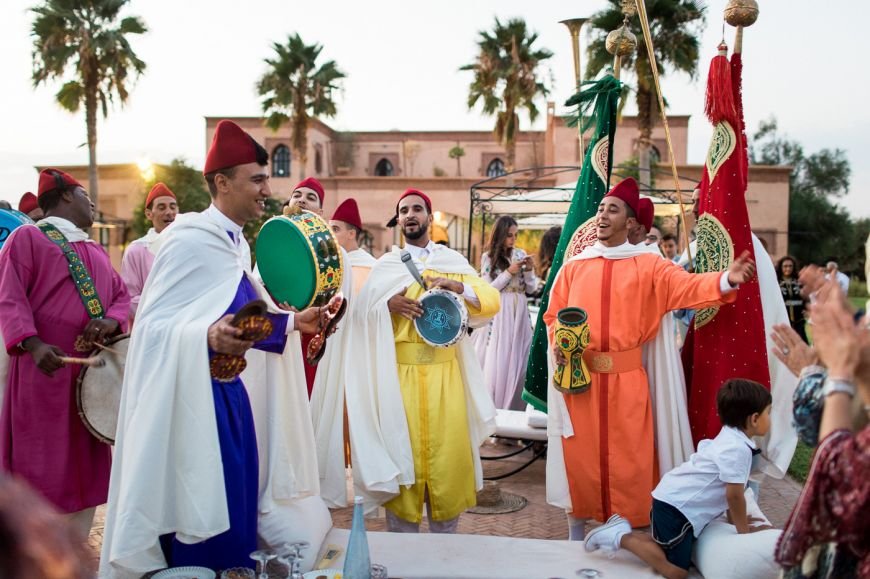
At Moroccan weddings, Chaabi is another favored music type. Born in Casablanca’s bustling streets, Chaabi music now reflects the joyful spirit of Moroccan wedding festivities. Its catchy beats, backed up by classic musical instruments like the oud and qanun, bring an undeniable liveliness to the atmosphere. This makes guests eager to join in on the fun and dance along.
When it comes to Moroccan weddings, the dances can be just as lively as the music. One much-loved dance is the Aissawa. This dance is full of zest, matching rhythms with detailed footwork and coordinated moves. Often seen at religious gatherings, the Aissawa symbolizes spiritual renewal.


At Moroccan weddings, you’ll often see a unique dance called the Ahidous. It’s a fascinating dance from the Berber tribes, showing off Morocco’s rich culture. With matching moves, detailed steps, and classic dress, it grabs everyone’s attention. Plus, it flaunts the country’s diverse regions.
Moroccan marriages are a vivid mix of tunes, moves, and happy noise. The couple enters with style and the event crescendos until the thrilling climax. Each snap in time is stamped with thrill and cheer. Those dear come in one place, making lasting memories, savoring tasty native food, and valuing the fresh ties between two households.
Vibrant Music, Energetic Dance, and Unforgettable Festivities
Moroccan weddings? They’re a brilliant display of the country’s energetic lifestyle and joyous vibe. You’ll hear music everywhere, see mesmerizing dances, and join in a party that leaves an unforgettable impression. Be it Gnawa’s captivating beats or Ahidous’s energetic moves, these weddings celebrate heritage. They bring folks together for a joyful event bubbling over with affection, fun, and cultural treasures.
| Music Genre | Description |
|---|---|
| Gnawa | African-influenced music combining captivating rhythms, chants, and instrumentals |
| Chaabi | Vibrant and upbeat music style originating from Casablanca, featuring traditional instruments |
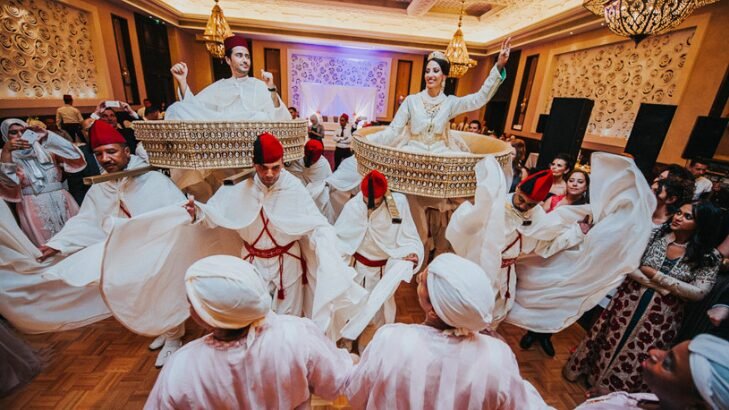
Conclusion
Moroccan wedding customs reflect the deep-rooted beauty of its culture. The wisdom of generations lives in these timeless traditions. Everything, from the careful before-wedding arrangements to the detailed clothes and gems, tells a tale of Moroccan heritage. Every facet of a Moroccan wedding carries traditional significance.
Joining in these traditions isn’t just about honoring family heritage. It’s about building unity and collective spirit. Think about a Moroccan wedding. It’s a festive event that gathers families, friends, and local communities. They form one happy crowd, creating special moments that last a lifetime and building stronger connections.
Moroccan weddings are a sensory delight. They’re packed with dynamic music, spirited dances, meaningful symbols, and unique rituals. Every part of it tells a vibrant story about Moroccan culture, highlighting the country’s creative arts and love for life.
Dipping into the practices of Moroccan weddings, you might find yourself awakened by a burst of radiant colors, lively music, and symbolic customs. It’s an encounter that sparks your senses, enhances your grasp of culture, and displays how traditions can unite people.
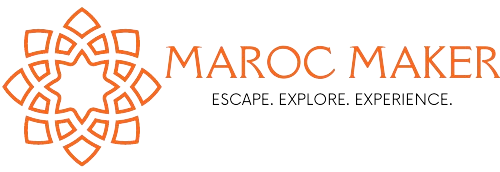
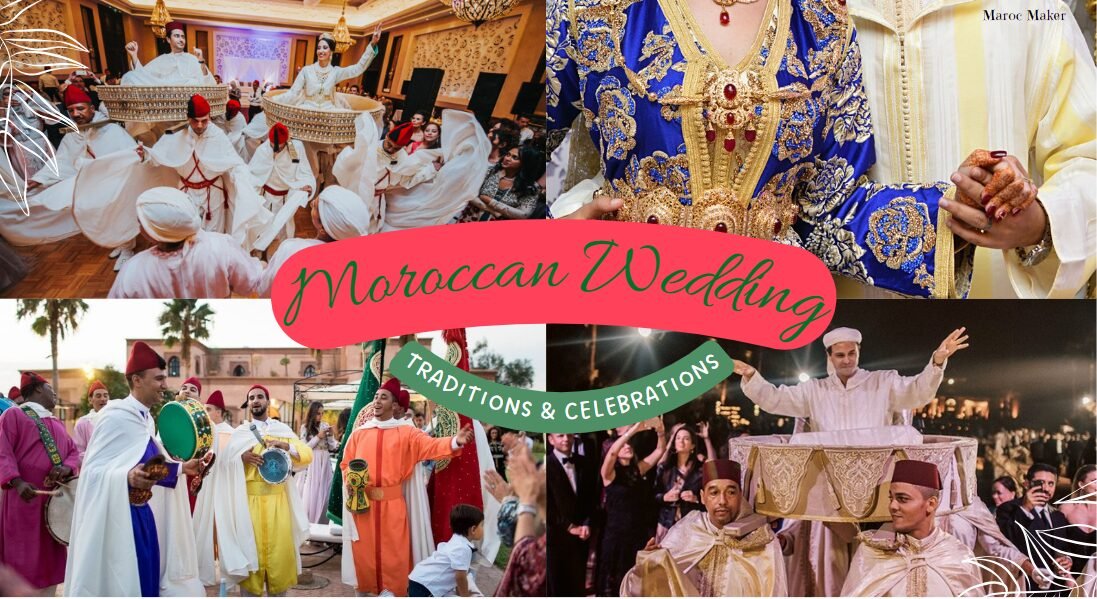


Comments are closed